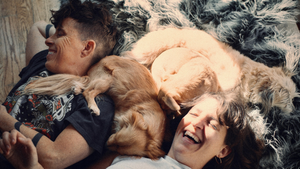Ralph Bunche rests in perpetuity around the corner. Elizabeth Cady Stanton is buried there. And a memorial to the victims of the Titanic can be found on the grounds.
But of all the famous permanent residents and displays at Woodlawn Cemetery in the Bronx, few attract as much attention as "Memorial To A Marriage," artist Patricia Cronin’s sculpture of two women’s passionate embrace in their bed.
“We’re the third most visited plot in the cemetery,” said Cronin about the installation that she and wife Deborah Kass intend to mark their graves. “It’s Miles Davis, Duke Ellington, and then us. We’re on all the tours.”
On Tuesday, their eternal resting place became more finalized when a new, bronze version replaced the original three-ton marble sculpture installed in 2003. A small crowd of cemetery staff members and installation crew marked the occasion on a dreary New York morning with Cronin and Kass, also an artist.
“Some people walk by and they go, ‘Oh, two angels. Oh, wait a minute,’” said Cronin of visitors to Woodlawn Cemetery, often compared to the famed Père Lachaise in Paris for its vast chronicling of history since the 19th century. “It lulls my audience into a false sense of security. Women’s history gets erased so often. Lesbian history barely gets written. As long as they are doing this walking tour, they are going to have to see there are two women there.”
The attraction lies in the traditional form, based on the sculptures that once dominated American cemeteries before museums became popular. The original marble work, designed with a grant from Grand Arts between 2000 and 2002, merged the historical purpose of sculpture with the political climate of the time and the Roman Catholic upbringing of Cronin, who was not yet 40 when she bought the burial plot, her “first and last real estate purchase.”
“I’d always designed it as a mortuary statue and I wanted to use an American neo-classical form to address what I consider a federal failure,” she said. “Since all we were legally afforded was death, I was going to make the most elegant statement on our government not allowing us to marry as I could muster.”
Times have changed since then, and Cronin and Kass, who have been together nearly 20 years, married in July on the first day the marriage equality law took effect in New York, the sixth state, not including the District of Columbia, to recognize same-sex couples’ freedom to marry. In some ways, the native New Englander feels far removed from the pre-Lawrence v. Texas days of wills, health care proxies, and power of attorney documents, but in other ways, not so distant.
“You still have a fraction,” she said. “It’s one step in the right direction, but its nowhere near the 1200 plus (federal) benefits. I’m glad now I won’t have a problem getting into a hospital room if Deb is sick.”
One decade later, Cronin sees exciting possibilities for the new bronze material compared to the original marble sculpture, which will be moved to an indoor exhibition. The marble needed to be covered every November to protect it from freeze-thaw that leads to cracking.
“People can touch it. It’s a little more tactile,” she said of the bronze, drawing a comparison to the grave marker of Victor Noir at Père Lachaise, where visitors rub the penis for fertility. “It can weather politics and the actual elements.”
One force Cronin has yet to encounter is the wrath of religious conservatives, where she cites theft and vandalism among her abiding concerns, but not political protests. As for putting the intimacy of her relationship with Kass on permanent public display, that risk goes with their occupational territory.
“I try to be brave in the studio,” she said. “Just be courageous and say the things that people are uncomfortable talking about. Otherwise, we’d all be painting daisies.”
Instead, Memorial To A Marriage marks the spot to push them up, for eternity.























































































 Cindy Ord/Getty Images
Cindy Ord/Getty Images

























